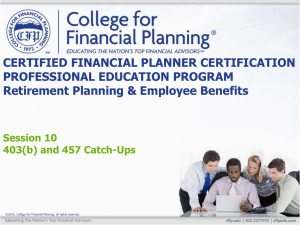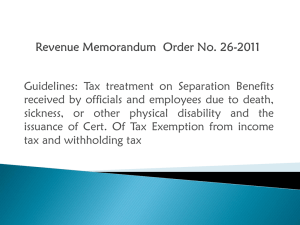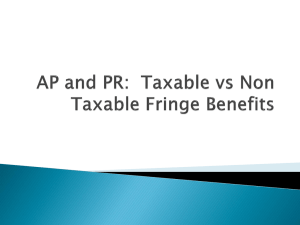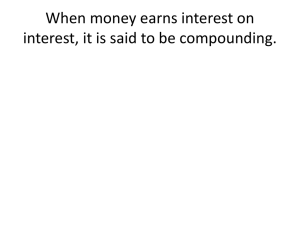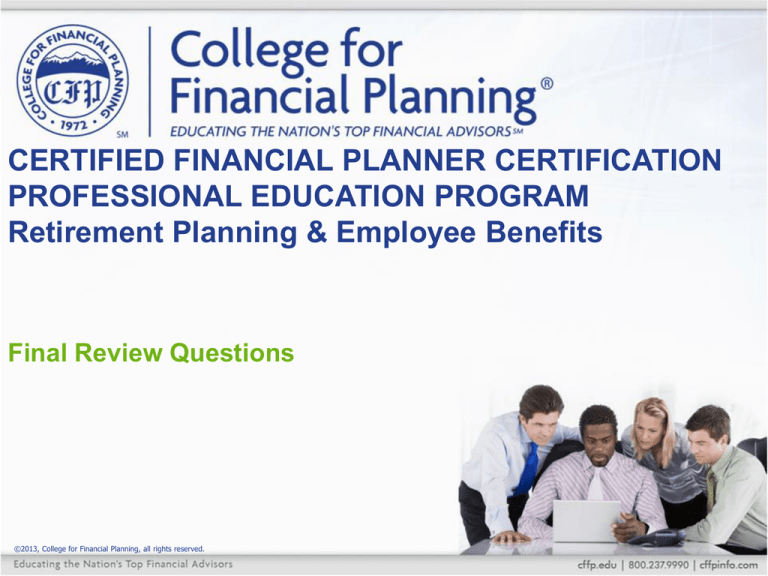
CERTIFIED FINANCIAL PLANNER CERTIFICATION
PROFESSIONAL EDUCATION PROGRAM
Retirement Planning & Employee Benefits
Final Review Questions
©2013, College for Financial Planning, all rights reserved.
Question 1
A fully insured worker is a worker who has
accumulated a minimum number of quarters of
coverage (credits). A quarter of coverage (credit)
is earned for each $1,160 (in 2013) that a worker
earns (up to four) per year.
How many quarters of coverage must a worker
have accumulated in order to be fully insured?
a. 13
b. 25
c. 36
d. 40
Key Terms in OASDI Programs
• Quarter of coverage ($1,160 in 2013)
• Currently insured/Fully insured
• Average Indexed Monthly Earnings (AIME)
• Full retirement age (FRA)
• Primary Insurance Amount (PIA)
• Spousal benefit
• Benefit reductions due to age
• Benefit reductions due to earnings
• Events that trigger the end of benefits
• Divorced spouse coverage (married 10 years)
Question 2
Which of the following workers are covered by
Social Security?
I. railroad employees with more than 10 years
of service
II. persons who are in the military
III.self-employed individuals
IV. domestic employees
a. I and II only
b. II and III only
c. I, II, and III only
d. II, III, and IV only
Groups Excluded from Social Security
• Federal employees hired prior to 1984
• Railroad employees covered under Railroad
•
•
•
•
Retirement System
Business owners receiving only distributive income
(dividends) for services performed
Children under age 18 employed by a parent in an
unincorporated business
State and local government groups covered by a
retirement system where employer has elected to
exclude Social Security coverage
Employees of religious organizations opting out for
religious reasons
Question 3
After meeting with your clients, the Smiths, you have
determined that their annual retirement income need, net of
expected Social Security benefits, will be $22,000 in today’s
dollars. They anticipate an annual after-tax return of 6% on their
investments, and they expect inflation to average 4% over the
long term. They also plan to retire in 25 years, and they want
their projected retirement income to last for 30 years.
Based upon this information, determine the lump-sum amount
(plus or minus $25) that the Smiths will need at the beginning of
retirement to fund their retirement.
a. $1,313,507
b. $1,327,503
c. $1,339,777
d. $1,353,036
Question 4
Judy and Charles Oakland want to retire in 12 years, at
which time they would like to have accumulated $350,000
in today’s dollars. To achieve this goal, they plan to invest a
sum at the end of each year that will remain constant in
purchasing power.
If they anticipate average inflation of 6% and after-tax
investment earnings of 9%, what payment is required at
the end of the first year?
a. $24,901
b. $26,395
c. $28,332
d. $32,508
Question 5
Which one of the following is not a characteristic
of a defined benefit plan?
a. The retirement benefit is not certain;
investment risk is borne by the participant.
b. Benefits are limited to the lesser of 100% of
compensation or $205,000 in 2013.
c. Forfeitures may only be applied to reduce
the employer’s contribution.
d. The plan requires annual actuarial
determinations of contributions.
Defined Benefit Plan Benefit Formulas
Flat benefit: Service is not considered
• Benefit is flat amount or percent of earnings
• Service reduction may be used: reduced benefit
for <X years of service
Unit benefit: Service is considered
• Benefit is a dollar amount per year of service or
a percentage of earnings per year of service
• Participant accrues additional benefit each year
• Service limitation may be used; considers years
of service up to specified maximum
Benefit Formula Examples
Funding
Formula
Benefit
Calculation
Example
Comments
Flat Amount
Formula
Flat amount per
month
$250 per month
No incentive for participants to
continue employment after
attaining maximum flat amount
Flat Percentage
Formula
Flat percentage
based on
compensation
10% of comp.
Per year
Incentive to increase
compensation through raises but
not to continue employment
after attaining a desired benefit
Unit Credit
Formula
Benefit
determined on a
combination of
service and
compensation
2% x years of
service x average
3 highest years
pay
Incentive to attain additional
years of service and additional
compensation to increase
ultimate benefit
Survivor Annuities
• Required of all pension plans
• QJSA 50% then a 75% QOSA (qualified optional
•
•
survivor annuity) must be offered or
QJSA 75% then a 50% QOSA must be offered
QPSA must also be offered
Question 6
Which one of the following characteristics is not
shared by defined benefit plans and target benefit
plans?
a. Qualified joint and survivor annuity
requirements apply.
b. Minimum funding requirements apply.
c. The contribution must be made each year.
d. Excess investment earnings result in greater
retirement benefits for participants.
Qualified Plan Characteristics (1)
Defined Contribution Plans
Basic Statutory
Characteristic
Cont. Type
Maximum
Employer
Deduction
Profit
Sharing/
Stock Bonus
Money
Purchase
Pension
Flexible
contribution
Fixed annual
contribution to meet
minimum funding
requirement
Target
Benefit
25% of covered payroll
Defined Benefit Plans
Cash Balance
Fixed % of
comp.; annual
actuarial
adjustment
Defined
Benefit
Annual actuarial
determination
Amount necessary to fund benefit
up to IRS limits
Qualified Plan Characteristics (2)
Defined Contribution Plans
Basic Statutory
Characteristic
Minimum funding
standard
Profit Sharing/
Stock Bonus
Money
Purchase
Pension
Defined Benefit Plans
Target
Benefit
Cash
Balance
Defined
Benefit
Generally No
Yes
Yes
Yes
Yes
Employee
contribution
401(k) provisions
allowed
May permit
voluntary
after-tax
N/A
N/A
May permit
voluntary
after-tax
Forfeitures
Generally
reallocated
Reallocated or applied to
reduce employer
contribution
Must be applied to reduce
employer contribution
Qualified Plan Characteristics (3)
Defined Contribution Plans
Basic Statutory
Characteristic
Annual additions
limit (415 limit)
Annual benefit
limit (415 limit)
Profit
Sharing/
Stock Bonus
Money
Purchase
Pension
Target
Benefit
Annual additions to a participant’s account
may not exceed the lesser of 100% of
compensation or $51,000 in 2013
N/A
N/A
N/A
Defined Benefit Plans
Cash
Balance
Defined
Benefit
N/A
N/A
Participant’s annual benefit
may not exceed lesser of
$205,000 or 100% of
compensation in 2013
Other Qualified Plan Characteristics
Defined Contribution Plans
Basic
Statutory
Characteristic
Most favored
age group
Defined Benefit Plans
Profit
Sharing/
Stock
Bonus
Money
Purchase
Pension
Target
Benefit
Cash
Balance
Defined
Benefit
Younger
Younger
Older
Younger
Older
Investment risk
Employee
Employer
Maintenance of
plan funds
Individual Accounts
Pooled Funds
Certainty of
retirement
benefits
1
PBGC insured
Uncertain
Guaranteed
minimum
return on
fund1
Specific
annual
benefit1
Question 7
All of the following may be included under the
IRS’s definition of compensation as it applies to
qualified plans except
a. employer contributions.
b. bonuses.
c. employer paid premiums for life insurance in
excess of $50,000.
d. salary reduction contributions.
Question 8
All of the following affect retirement benefits in a
defined benefit plan except
a. investment earnings on the plan’s assets.
b. the participant’s compensation.
c. the participant’s years of service.
d. the plan’s formula.
Question 9
Which of the following statements is true about
the 50/40 test?
a. If at least 40 employees are covered, then
the plan passes.
b. If less than 50 employees are covered, then
the plan fails.
c. If there are only three employees, then at
least two must be covered.
d. If there are union employees, then they
must also be considered when doing the
50/40 test calculation.
Defined Benefit Plan Minimum Participation Test
Defined benefit plans also must satisfy the
minimum participation (50/40) test. The plan must
benefit at least the lesser of
• 50 employees, or
• The greater of:
o 40% of all the company’s ERISA eligible
employees, or
o Two employees (one employee if there is
only one employee)
Question 10
Which one of the following types of qualified plans
does not allow Social Security integration?
a. profit sharing plan
b. target benefit plan
c. employee stock ownership plan (ESOP)
d. stock bonus plan
Question 11
Jim Hanson, age 35, is the 100% shareholder and
president of an incorporated business that has no
retirement plan for its 20 full-time and 28 part-time
employees. Jim’s goal is to maximize his retirement
contributions; however, Jim wants to avoid fixed employer
contributions.
Which one of the following retirement arrangements should
the corporation adopt?
a. tandem plan
b. target benefit plan
c. money purchase plan
d. profit sharing plan
Question 12
Which one of the following is not correct about qualified
plan limits for profit sharing 401(k) plans?
a. The retirement benefit is not certain; investment
risk is borne by the participant.
b. Includible compensation is limited to the lesser of
100% of compensation or $205,000 in 2013.
c. The employer contribution limit is 25% of
compensation.
d. The maximum allowable employee deferral amount
is $17,500, not counting any catch-ups, in 2013.
Question 13
Which one of the following statements correctly
describes the term “elective deferral”?
a. the ratio of nonhighly compensated
employees’ benefits to highly compensated
employees’ average compensation
b. the dollar amount of forfeitures being
allocated to a 401(k) plan participant
c. the dollar amount contributed by the
employer into a 401(k) plan
d. the dollar amount contributed by an
employee into a 401(k) plan
Question 14
Which one of the following would classify an
employee as being highly compensated?
a. 5% or less owner
b. greater than 5% owner
c. 10% or less owner
d. greater than 10% owner
Highly Compensated Employee
• Was a “5% owner” (ownership of >5%) in the
•
determination year or in the preceding plan
year or
In 2013, a person whose compensation was in
excess of $115,000 in the previous year (2012)
is a highly compensated person.
o Employer has the option to limit highly
compensated to the top-paid 20%
employees based upon preceding year’s
compensation.
Question 15
Harry, a frantic 34-year-old, contributed $2,000 to a Roth
IRA in January 2010. By January 2013, the investments in
his account had grown to $3,785. Finding himself in a
financial bind, Harry is now compelled to withdraw $2,000
from this Roth IRA. What is the tax and penalty status of
this withdrawal?
a. Harry must pay tax on the $2,000, but there is no
penalty.
b. Harry must pay tax and a $200 penalty.
c. Harry does not have to pay any tax or penalty on
the $2,000 distribution, even though he is only 34.
Question 16
James and Doris Stewart will contribute a total of $11,000
to their IRAs for this tax year. They both work outside the
home, and they file a joint tax return. James Stewart is a
teacher at the local high school and contributes to a TSA.
Doris’s employer has no retirement plan. Their adjusted
gross earnings for this year will be $105,000.
What amount, if any, can they deduct for their IRA
contributions?
a. $0
b. $5,500
c. $8,250
d. $11,000
IRA Deductibility Active Participant Status
An employee is an active participant in a defined contribution plan if,
during the taxable year, the employee received any annual additions to
his/her account.
Employer
Contribution
or
Employee Contribution
(either voluntary or mandatory)
or
Forfeiture
To one of the following plans:
•
•
•
•
All qualified plans
Tax-sheltered annuity (TSA) under §403(b)
Simplified employee pension (SEP) & SIMPLE plans
Government pension plan
An employee is an active participant in a defined benefit plan if the
employee is eligible to participate in the plan, whether or not
participation is waived. (Note that investment earnings do not affect
active participant status.)
Traditional IRA Deduction Phaseout Amounts (2013)
Single Taxpayer
Not an Active Participant
Active Participant
No Phaseout
$59,000-$69,000
Married Taxpayers Filing Jointly
Neither is an Active
Participant
One Active
Participant
Both Active
Participants
No Phaseout
Active participant:
$95,000-$115,000
$95,000-$115,000
Other Spouse:
$178,000-$188,000
Question 17
Allen Baker, a single taxpayer with AGI of $76,000, is
covered by his employer’s profit sharing/401(k) plan.
During the current plan year, no employer contribution was
made, and Allen did not make any salary reduction
contributions to the 401(k) portion of the plan. Allen’s
account balance increased by $120 this year, which was
attributable to investment earnings of $80 and forfeitures
of $40.
If he contributes $5,500 to his IRA for this year, what is the
amount of his allowable IRA deduction?
a. $0
b. $600
c. $1,200
d. $5,500
Question 18
Which one of the following is not exempt from the
10% penalty tax on premature distributions from
an IRA?
a. a series of substantially equal periodic
payments
b. a distribution following the owner’s death
c. a distribution to a 55-year-old employee
following separation from service
d. a distribution following disability
e. a distribution for medical expenses in excess
of deductible medical expenses
Question 19
Which of the following categories of employers are
able to offer Section 403(b) plans?
I. public education systems
II. state and local government entities
III.certain tax-exempt organizations
IV. sole proprietors
a. I and II
b. I and III
c. II and III
d. III and IV
Qualified Employer & General Plan Features
Qualified employers
• Public educational systems
• 501(c)(3) organizations
• Ministers performing religious services for forprofit companies
• 403(b) plans are not considered to be qualified,
were around before ERISA
Two basic types of 403(b) arrangements
• Employee-deferral only
• Employer contribution and employee deferral
Question 20
Which of the following describes the nondiscrimination test
that a deferral-only 403(b) plan must satisfy?
a. If the plan benefits at least 70% of the non-key
employees, the ratio test is satisfied.
b. The ratio test can be satisfied only if the percentage
of nonhighly compensated employees equals at
least 75% of the percentage of highly compensated
employees.
c. If the plan allows any employee who will defer a
minimum of $200 per year to participate, it satisfies
the non-discrimination requirements.
d. The plan is not considered discriminatory if at least
70% of the HCEs benefit.
401(k) & 403(b) Plan Comparison
Characteristic
401(k)
403(b)
Sponsor?
Nongovernmental
employers
Public schools and 501(c)(3)
Private employer?
Yes
No
Qualified plan?
Yes
No
Eligibility?
ERISA requirements
Any employee (typically)
Salary deferral?
Yes
Yes
Matching allowed?
Yes
Yes, but seldom done
Nonelective contributions?
Yes
Yes, but seldom done
Nondiscrimination tests?
Yes
No, if only salary deferral
Yes, if employer
contributions
401(k) & 403(b) Plan Comparison (2)
Characteristic
Maximum deferral?
401(k)
$17,500 in 2013 (indexed)
403(b)
$17,500 in 2013 (indexed)
Overall limits?
Loans?
The lesser of the 415(a)
limit or annual deferral limit
Yes, for those age 50 and
older
Yes
The lesser of the 415(a)
limit or annual deferral limit
Yes, two, age 50 and 15
years of service
Yes
Hardship withdrawal?
Yes
Yes
Investment limitations?
No (all ERISA investments)
ADP and ACP testing?
Yes, unless safe harbor plan
Yes, only mutual funds and
annuities
Only ACP testing, safe
harbors available
Catch-up election?
Question 21
Based upon George’s salary and years of service,
he could contribute $17,500 to the Section 403(b)
plan in which he participates. However, during the
summer he paints homes and contributes $4,500
into a SIMPLE IRA through that employer.
How much can George contribute to the Section
403(b) plan?
a. $7,500
b. $12,000
c. $13,000
d. $17,500
Question 22
The vested accrued benefit in George’s TSA is $87,500. He has
never taken a loan from the plan, but is now interested in
building an addition to his home.
Which of the following statements correctly describes George’s
option?
a. The amount of the loan would be limited to $43,750 and
the term would be limited to five years.
b. George could borrow up to $43,750; and since the loan
is for his primary residence, it could be longer than five
years.
c. George can borrow up to $50,000, but the term of the
loan would be limited to five years.
d. The amount of the loan would be limited to $50,000;
and since the loan is for his primary residence, it could
be for longer than five years.
Question 23
Which of the following statements correctly identifies the
tax consequences of a hardship withdrawal from a profit
sharing plan?
a. Since profit sharing plans are qualified, a hardship
distribution is subject only to income taxation
without any penalty.
b. All hardship withdrawals would be subject to both
taxation and a 10% penalty.
c. Hardship withdrawals that are used to pay certain
medical expenses would be subject to income tax,
but not to the tax penalty.
d. Hardship withdrawals used to pay for postsecondary education would be subject to income
tax, but not to the penalty tax.
Question 24
Which of the following statements correctly describes a Section 457 catch-up provision?
a.
b.
c.
The final three-year catch-up provision allows all participants of a Section 457
plan to contribute an additional $17,500 during the three years preceding
retirement. The other catch-up is for those who have attained age 50. They
can increase their deferrals by $5,500 (in 2013) in all but the last three years
before retirement.
The final three-year catch-up provision allows participants to make
contributions up to twice the maximum deferral allowed for a 457 plan. The
additional deferral amount is available only from prior unused deferrals and is
to make up for those years when deferrals were less than the maximum
allowed. The other catch-up is for those who have attained age 50. They can
increase their deferrals by $5,500 (in 2013) in all but the last three years
before retirement if they use the final three-year catch-up.
During the final three years before retirement, a participant in a Section 457
plan could contribute up to the lesser of 100% of compensation, or $51,000.
The other catch-up is for those who have attained age 50. They can increase
their deferrals by $5,500 (in 2013) in all but the last three years before
retirement.
Catch-up Provisions of 457(b) Plans
Age 50 catch-up
• Additional $5,500 for those age 50 and older not in the
final three years prior to retirement
Final three years catch-up
• Available for each year of the three years preceding
normal retirement age
• Catch-up contribution up to the allowable deferral for
the current year, resulting in total deferrals up to two
times the allowable deferral for the current year
• From unused deferrals only
• Cannot use with age 50 catch-up
Question 25
In the first two years, a SIMPLE IRA may be rolled
over into which one of the following?
a. another SIMPLE IRA
b. a qualified plan
c. an IRA
d. a SEP
SIMPLE IRA
•
•
•
•
•
100 or fewer employees paid at least $5,000 in any two
preceding years and current year—must be only plan
Permits employee elective deferrals ($12,000 with $2,500
age 50 catch-up)
100% immediate vesting
Nondiscrimination tests met if:
o 100% match on first 3% (1% match in 2 of 5 years), or
2% non-elective contribution to account of each
employee earning more than $5,000
IRA distribution rules apply, except
o 25% penalty on withdrawals in initial two years
o Rollovers limited during initial two years
Permissible Rollovers
Roll from
Roll to
IRA
SEP-IRA
SIMPLE
IRA
Roth IRA
IRA
YES
YES
NO
YES, but taxable
SEP-IRA
YES
YES
NO
SIMPLE IRA
YES, after
two years
YES, after
two years.
Roth IRA
NO
457(b)
Government
457(b)
403(b)
Qualified
Plan
Designated Roth
Account
YES, must have
separate
accounts.
YES
YES
NO
YES, but taxable
YES, must have
separate
accounts.
YES
YES
NO
YES
YES, after two
years, is taxable
YES, must have
separate
accounts.
YES, after
two years
YES, after
two years.
NO
NO
NO
YES
NO
NO
NO
NO
YES
YES
NO
YES, but taxable
YES
YES
YES
NO
403(b)
YES
YES
NO
YES, but taxable
YES, must have
separate
accounts.
YES
YES
NO
Qualified
Plan
YES
YES
NO
YES, but taxable
YES, must have
separate
accounts.
YES
YES
NO
Designated
Roth
Account
NO
NO
NO
YES
NO
NO
NO
YES, if a direct
trustee to trustee
transfer.
Question 26
Which one of the following is a correct statement
about the constructive receipt doctrine?
a. It may tax income that is made available but
is not yet received by a taxpayer.
b. It taxes payments made in the future that
are based on a company’s earnings.
c. It prevents a deferred compensation
agreement from being informally funded.
Constructive Receipt
• The constructive receipt issue isn’t whether the
•
taxpayer has actually received the income, but
whether he/she has access to it.
To avoid constructive receipt, agreements
usually contain specific provisions establishing
substantial risk of forfeiture (funded plans), or
availability of funds to company’s general
creditors (unfunded plans).
Question 27
Which one of the following is a requirement for
incentive stock options (ISOs)?
a. ISOs, with limited exceptions, must be made
available to all employees.
b. ISOs, when granted, can be issued at a
discount of up to 15% from the current fair
market value of the company stock.
c. ISOs must be exercised within three months
of retirement in order to preserve favorable
tax treatment.
d. ISOs require approval only from senior
management.
Tax Treatment of Incentive Stock Options
• No income tax is owed when the ISOs are granted.
• No income tax is owed when the ISOs are exercised.
• The difference between grant and exercise price is AMT
•
•
income in year of exercise (if stock is disposed of in
same year as exercise, no AMT income).
Income tax is owed when the stock purchased with the
ISOs is sold.
How the gain will be taxed depends on whether the
disposition is a “qualifying disposition” or a
“disqualifying disposition.”
Question 28
Joseph Scarpelli is an employee of Cabinet Masters, Inc., a publicly held
corporation. Joseph’s salary is $35,000 per year. Cabinet Masters is
considering the adoption of a group term life insurance plan on its
5,000 employees, whereby each will be offered life insurance in an
amount equal to twice his or her current salary. The premiums will be
paid by Cabinet Masters. Joseph, a single individual, wants to name the
American Cancer Society, a charitable organization, as beneficiary of
his group life proceeds.
Which of the following identifies the income tax implications of the cost
of this group term life insurance coverage for Joseph?
a. Since Joseph can change the beneficiary at any time, the cost
of $20,000 of the coverage will be taxable income.
b. With this beneficiary arrangement, Joseph will not have any
tax consequences.
c. Cabinet Masters, and not Joseph, will have to pay taxes on any
premiums that are paid.
Question 29
Which of the following statements describes the tax
implications of disability insurance?
a. If premiums are paid 100% by the employer,
benefits are not considered taxable income to the
employee as long as the employee qualifies under
the Social Security definition of disability.
b. If the employee pays 100% of the premiums,
benefits paid to the employee are not considered
taxable income.
c. If the employer purchases disability coverage on a
key employee and benefits are payable to the
employer, the employer can deduct the expense of
premium payments, but benefits are taxable
income.
Question 30
Which of the following events are considered a
qualifying even under COBRA?
I. involuntary termination of an employee due
to gross misconduct
II. any voluntary termination or a change from
full-time to part-time status
III.dependent’s loss of dependent status
IV. employee’s death or divorce
a. I and II only
b. II and III only
c. II, III, and IV only
d. I, II, III, and IV
COBRA Qualifying Events
Qualified beneficiaries
Covered employee
Qualifying events
Length of coverage
Voluntary or involuntary
termination
18 months
Change from full-time to parttime status
18 months
Disability (S.S. definition)
29 months
Plan termination
36 months
Spouses and other
dependents
Employee’s
• Death
• Divorce
• Legal separation
• Eligibility for Medicare
36 months
Children of employees
Loss of dependent status
36 months
Question 31
Which of the following benefits would not create
taxable income for employees, assuming that the
plans are nondiscriminatory?
I. country club dues paid by the employer
II. de minimis fringe benefits
III.qualified employee discounts
IV. business use of an employer-owned
automobile
a. I and II only
b. II and III only
c. II, III, and IV only
d. I, II, III, and IV
Taxable Non-Cash Fringe Benefits
• Personal use of company automobile or lodging
• No-additional-cost services and qualified
•
•
employee discounts to highly paid employees if
not available to rank-and-file employees
Country club dues paid for employees
Season tickets
Non-Taxable Non-Cash Fringe Benefits
•
•
•
•
•
•
Working condition fringe benefits
(must be business related and substantiated)
o business use of company car,
o professional dues and subscriptions
No-additional-cost services
Qualified employee discounts
Use of on-premises athletic facilities
De minimis fringe benefits
o limited use of copy machine
o occasional tickets for business purposes
o public transportation allowances up to $245 per month
o qualified parking also $245 per month
Meals and lodging furnished for employer’s convenience
Question 32
Select the basic provisions of an IRC Section 401(k) plan from the
following statements.
I. Employee elective deferrals are exempt from income tax
withholding and FICA and FUTA taxes.
II. An employer’s deduction for a contribution to a Section 401(k)
plan cannot exceed 25% of covered payroll, and the deduction
is not reduced by the employees’ elective deferrals.
III. A Section 401(k) plan cannot require as a condition of
participation that an employee complete a period of service
longer than one year.
IV. Employee elective deferrals may be made from salary or
bonuses.
a. I and III only
b. I and IV only
c. II and IV only
d. I, III, and IV only
e. II, III, and IV only
Question 33
Which of the following are correct statements about Keogh
plans?
I. Benefits provided by a defined benefit Keogh plan cannot
exceed the lesser of $205,000 in 2013 or 100% of salary.
II. Keogh plans are qualified plans established by any
unincorporated business entity.
III. Keogh contributions for owner-employees are based on
their gross salary.
IV. Keogh plans are permitted to make loans to common-law
employee participants and owner-employees.
a. I and II only
b. I and III only
c. II and IV only
d. I, II, and IV only
e. II, III, and IV only
Keogh Plans—Basic Provisions
• Available only to unincorporated businesses — sole
•
•
proprietor or partnership
Takes the form of a qualified plan (defined contribution
or defined benefit)
Certain provisions for owner/employee are unique to
Keoghs:
o Owner/employee’s contribution is calculated on net
earnings
o Lump-sum distribution treatment is not available to
owner/employee for separation from service before
age 59½—available only for death, disability, or
attainment of age 59½
Question 34
Which of the following would not be considered
unrelated business taxable income (UBTI)?
a. limited partnership income
b. royalty income
c. income from a directly held business
d. dividend income from leveraged stock
UBTI
UBTI (unrelated business taxable income) is derived
when a qualified plan participates in running a business.
Income not considered to be UBTI
• Passive income (interest, dividends, royalties, rent)
• Capital gains
• Leveraged real estate that is held directly
Income considered to be UBTI
• Income from a directly held business
• Dividend income, if stock is margined
• Partnership income (general and limited)
Question 35
Which of the following qualified plans are required
to provide a qualified joint and survivor annuity
(QJSA)?
I. cash balance plan
II. certain ESOPs
III.target benefit plan
IV. thrift plan
a. I and II only
b. I and III only
c. III and IV only
d. I, II, and IV only
e. II, III, and IV only
Question 36
Which one of the following statements is correct?
a. ADP testing measures employee and
employer deferrals.
b. ACP testing measures employee after-tax
deferrals.
c. The ratio percentage test uses key
employees.
d. The average benefits test uses highly
compensated employees.
Question 37
John, age 52, has worked for a local hospital for
17 years, and earns $75,000 a year. The hospital
offers a 403(b) plan, and John has asked you what
would be the maximum amount he could defer this
year.
You would advise him that he could potentially
defer
a. $12,000.
b. $17,500.
c. $23,000.
d. $26,000.
Question 38
Which one of the following is applicable to both
governmental and non-governmental Section 457
plans?
a. Both have the final three-year catch-up
available allowing twice the deferral amount.
b. Upon separation from service, both can be
transferred to a qualified plan.
c. Both are considered to be unfunded, and
potentially subject to the claim of creditors.
d. If the employer elects as such, both can
allow loans.
Funded & Unfunded 457(b) Plans
Nongovernmental 457(b) plans:
• Unfunded (money may be set aside, but is
available to creditors)
• Participant does not have constructive receipt
• Since unfunded no loans allowed
• No rollovers allowed (such as to an IRA)
Governmental 457(b) plans:
• Funded (funds are not at risk)
• Loans are allowed
• Can be rolled over to an IRA, Roth IRA, SEP,
403(b), or qualified plan
Question 39
Which of the following legal requirements apply to employee stock
ownership plans (ESOPs)?
I. ESOPs must permit participants who have reached age 55 and
have at least 10 years of service the opportunity to diversify
their accounts.
II. ESOPs cannot be integrated with Social Security.
III. A C corporation’s deduction for ESOP contributions and
amounts made to repay interest on an ESOP debt cannot
exceed 25% of the participants’ payroll.
IV. The mandatory 20% income tax withholding requirement does
not apply to distributions of employer stock from an ESOP.
a. I and II only
b. II and III only
c. I, II, and III only
d. I, II, and IV only
e. II, III, and IV only
Question 40
Which of the following is (are) true about both incentive stock options
(ISOs) and nonqualified stock options (NSOs)?
I. Upon exercise, both are taxable as compensation, subject to
payroll taxes (Social Security).
II. If held for at least two years from the grant date and one year
from the date of exercise, both are eligible for capital gains
treatment on any gain above the grant price.
III. Only employees are eligible to receive either ISOs or NSOs.
IV. Both ISO and NSO grant prices must be at fair market value
at the time of issue.
V. Generally, neither is taxed upon being granted since there is
no ascertainable value when granted.
a. III only
b. V only
c. II and III only
d. IV and V only
e. I, III, and V only
CERTIFIED FINANCIAL PLANNER CERTIFICATION
PROFESSIONAL EDUCATION PROGRAM
Retirement Planning & Employee Benefits
Final Review Questions
End of Slides
©2013, College for Financial Planning, all rights reserved.

